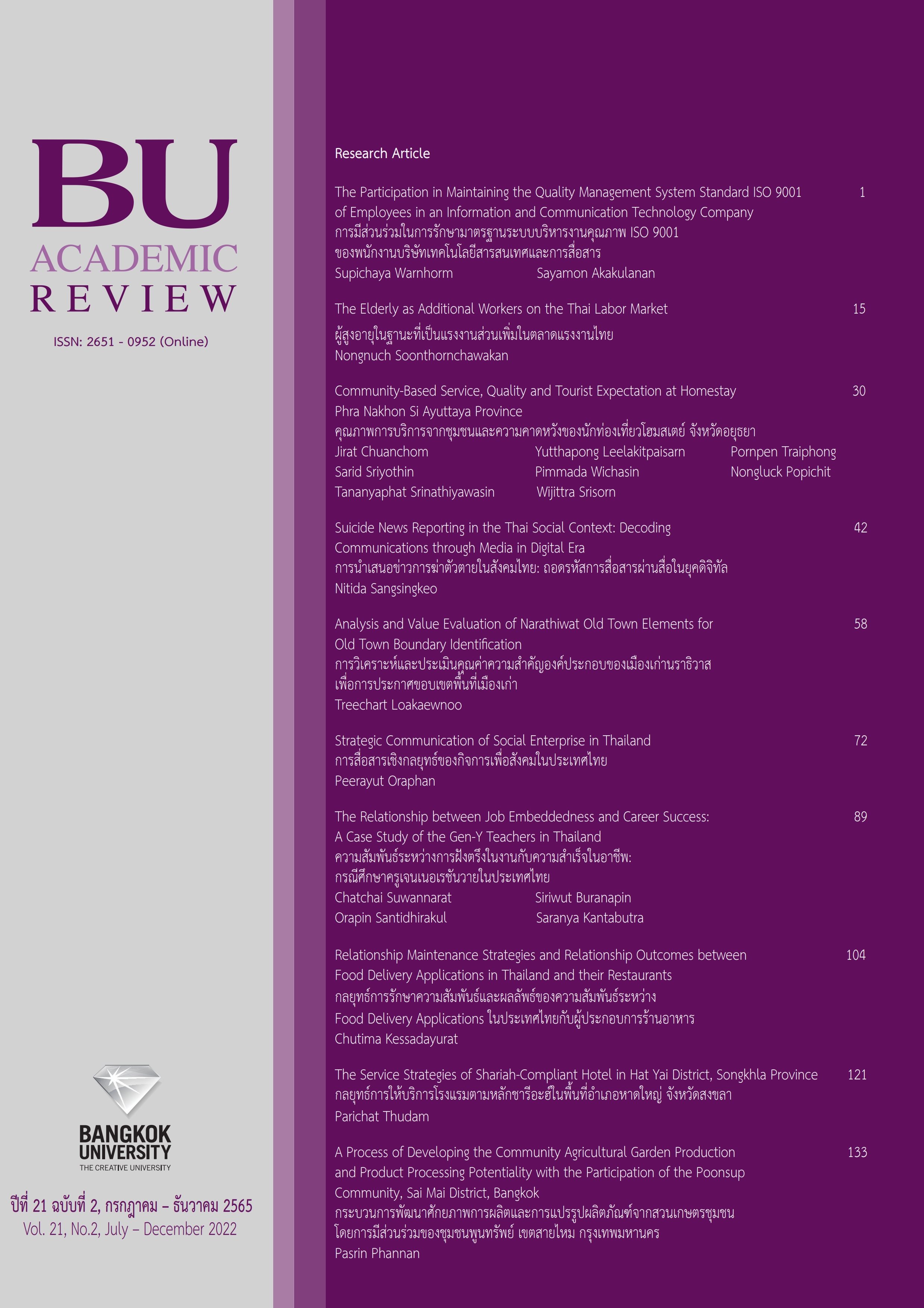The Elderly as Additional Workers on the Thai Labor Market
Main Article Content
Abstract
This paper extends the life cycle labor supply model of individual to explain the impact of the recession on all members of extended family, which includes both working-age worker and the elderly. Model of family joint utility maximization suggests that the reduction of family’s income due to the labor earnings loss of the breadwinner will cause the increase in the work of the elderly in the extended family, such as parents in retirement age. The paper finds an increase in the labor force participation rate and employment rate of the elderly in Thailand during the economic crisis due to the Covid-19 pandemic where unemployment and underemployment of young and prime age workers increase. Due to the fact that many Thai elderly people rely on income from their children, therefore these evidences imply that some elderly people respond to job and income losses of children by adjusting the labor supply as additional workers on the labor market. Moreover, the elderly workers are affected by this crisis in terms of unemployment as well. Hence, the working situation of elderly workers should be more concerned.
Article Details

This work is licensed under a Creative Commons Attribution-NonCommercial-NoDerivatives 4.0 International License.
The manuscript submitted for publication must be the original version, submitted only to this particular journal with no prior acceptance for publication elsewhere in other academic journals. The manuscript must also not violate the copyright issue by means of plagiarism.
References
Adhikari, R., Soonthorndhada, K., & Haseen, F. (2011). Labor force participation in later life: Evidence
from a cross-sectional study in Thailand. BMC Geriatrics, 11(15), 1-8.
Bank of Thailand. (2020). Sō̜ng talāt rǣngngān Thai . . . fư̄ntūa khǣ nai lang pœ̄t mư̄ang [Look at the
Thai labor market...how recovered after opening the city]. Retrieved May 15, 2022, from https://www.bot.or.th/Thai/MonetaryPolicy/MonetPolicyComittee/MPR/BOX_MPR/BOXMPR_Q32563_1Labor.pdf
Bhuvapanich, S. (2010). Rabop bamnān Thai: Patčhai thī khūan khamnưng thưng phư̄a kāo tō̜ pai nai
kān padirūp [Thai pension system: Factors that should be taken into account for the next step in the reform]. Retrieved May 20, 2022, from http://prp.trf.or.th/trf-policy-brief
Cahuc, P., McCuaig, W., & Zylberberg, A. (2004) Labor economics. Cambridge, Massachusetts: MIT
Press.
Heckman, J. J. (1974). Life cycle consumption and labor supply: An explanation of the relationship
between income and consumption over the life cycle. The American Economic Review, 64(1),
-194.
Heckman, J. J., & Macurdy, T. E. (1980). A life cycle model of female labour supply. The Review of
Economie Studies, 47(1), 47-74.
Kooij, D. T. A. M. (2020). The impact of the Covid-19 pandemic on older workers: The role of self-
regulation and organizations. Work, Aging and Retirement, 6(4), 233-237.
Kulthanavit, P., & Soonthornchawakan, N. (2019). Kāntatsinčhai tham ngān læ čhāng ngān tō̜ ʻaha lang
kasīanʻāyu: Bot samrūat phāksanām [Evidence from the survey of post-retirement
employment decisions]. BU Academic Review, 18(1), 148-164.
Liao, L., & Paweenawat, S. W. (2019). Alternative boomerang kids, intergenerational co-residence, and
maternal labor supply. Retrieved April 20, 2022, from https://www.pier.or.th/files/dp/pier_dp_108.pdf
Lundberg, S. (1985). The added worker effect. Journal of Labor Economics, 3(1), 11-37.
Gong, X. (2010). The added worker effect and the discourage effect for married women in Australia
Retrieved April 20, 2022, from https://docs.iza.org/dp4816.pdf
MaCurdy, T. E. (1981). An empirical model of labor supply in a life cycle setting. The Journal of
Political Economy, 89(6), 1059-1085.
Matsuyama, Y. (2021). Aging, safety net and fiscal crisis in Japan No.332: The number of
elderly workers has continued to increase even during the COVID-19 pandemic.
Retrieved April 20, 2022, from https://cigs.canon/en/article/20211006_6267.html
Melvin, S. J. (2002). Worker displacement and the added worker effect. Journal of Labor Economies,
(3), 504-537.
Mincer, J. (1958). Investment in human capital and personal income distribution. The Journal of
Political Economy, 66(4), 281-302.
Ministry of Information and Communication Technology. (2014). Kānsamrūat prachākō̜n phūsūngʻāyu
nai prathēt Thai Phō̜.Sō̜. sō̜ngphanhārō̜ihāsipčhet [The 2014 survey of older persons in
Thailand]. Bangkok: Ministry of Information and Communication Technology.
Office of the National Economic and Social Development Council. (2021). Phāwa sētthakit Thai trai māt thī sō̜ng khō̜ng pī sō̜ngphanhārō̜ihoksipsī læ nǣonōm pī sō̜ngphanhārō̜ihoksiphā [Thai economic conditions in the second quarter of 2021 and outlook for 2022]. Retrieved April 20, 2022, from https://www.nesdc.go.th/ewt_dl_link.php?nid=12288
Phuphaibul, R., Jongudomkarn, D., Nieamsup, T., Tejagupta, C., Kumhom, R., Wacharasin, C., Thayansin,
S., Patrayotin, N., Portawin, T., Deoisres, W., Patumwan, A., & Nityasuddhi, D. (2018). Kān plīan plǣng khrōngsāng khrō̜pkhrūa Thai tām wongčhō̜n chīwit: Kānsưksā bư̄a ngota [Structural change of Thai families, according to family life cycle: A preliminary study]. Journal of Demography, 34(1), 58-71.
Paweenawat, S. W., & Liao, L. (2021). Labor supply of older workers in Thailand: The role of co-
residence, health, and pensions (ADBI Working Papers. 2021-1224). Retrieved April 20, 2022, from https://www.adb.org/sites/default/files/publication/687656/adbi-wp1224.pdf
Quinby, L., Retledge. M. S., & Wettstein. G. (2021). How has Covid-19 affected older workers’ labor
force participation. Retrieved April 20, 2022, from https://crr.bc.edu/wp-content/uploads/2021/11/IB_21-20.pdf
Soonthornchawakan, N. (2011). National transfer accounts (NTA) of Thailand: Gender difference.
Bangkok: Thailand Development Research Institute (TDRI) and Nihon University Population Research Institute (NUPRI).
Soonthornchawakan, N. (2016). Kānthamngān læ phontō̜pthǣn khō̜ng phūsūngʻāyu Thai [The workings
of the Thai elderly and their earnings]. Executive Journal, 36(1), 62-78.
Trades Union Congress. (2022). Older workers after the pandemic: Creating and inclusive labour
market. Retrieved April 20, 2022, from https://www.tuc.org.uk/research-analysis/reports/older-workers-after-pandemic-creating-inclusive-labour-market
Wice, S. E. (2021). Millions of workers retired during the pandemic. The economy needs
them to “unretired,” expert say. Retrieved April 20, 2022, from https://www.cbsnews.com/news/retirement-covid-pandemic-unretire-labor-shortage/
Woytinsky, W. S. (1940). Additional workers on the labor market in depression: A reply to Mr.
Humphrey. Journal of Political Economy, 48(5), 735-739.


